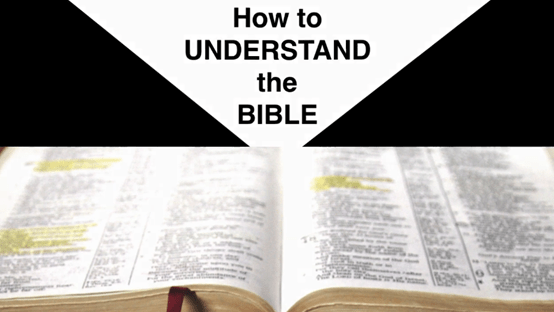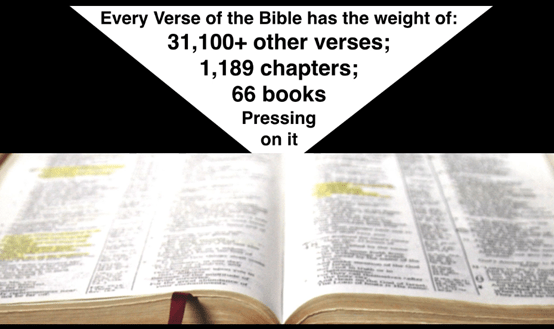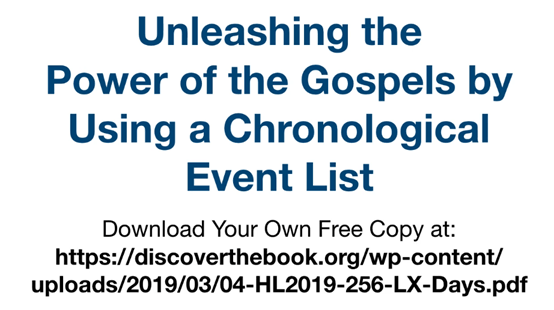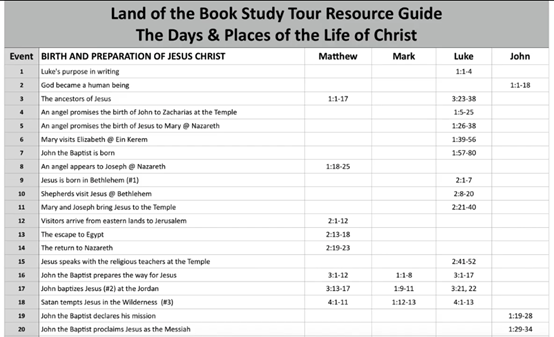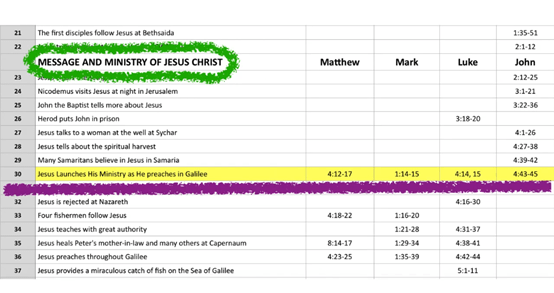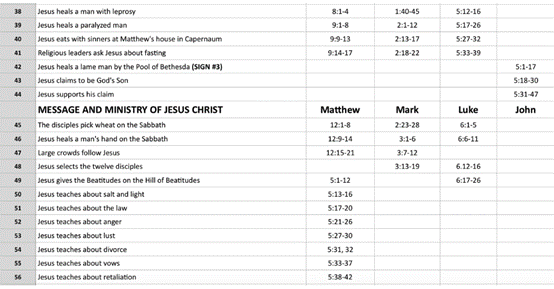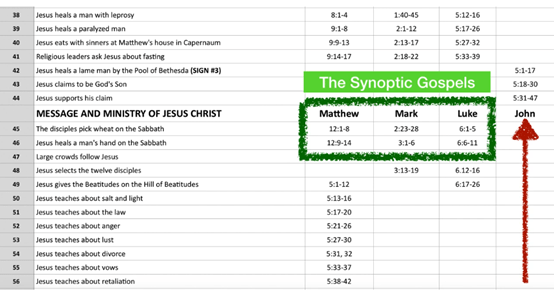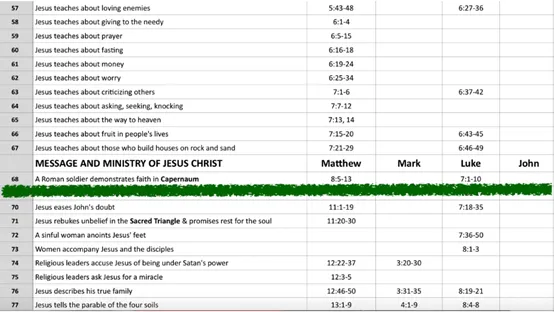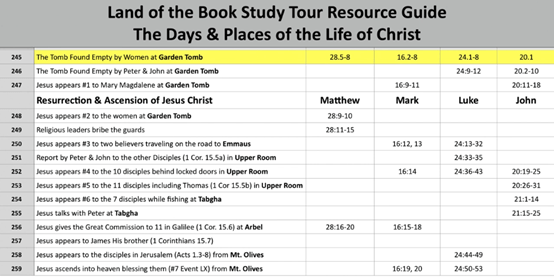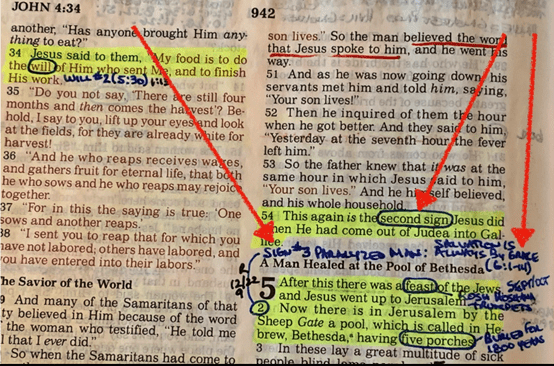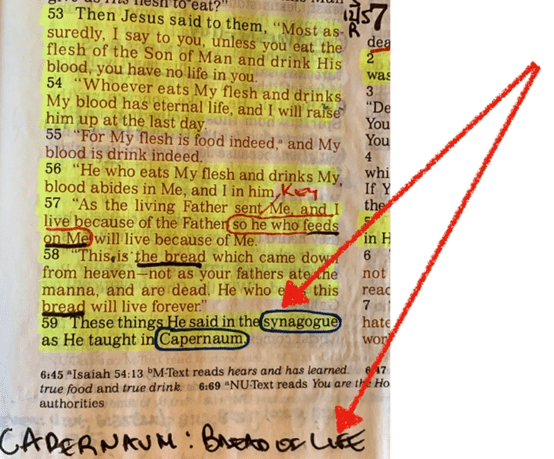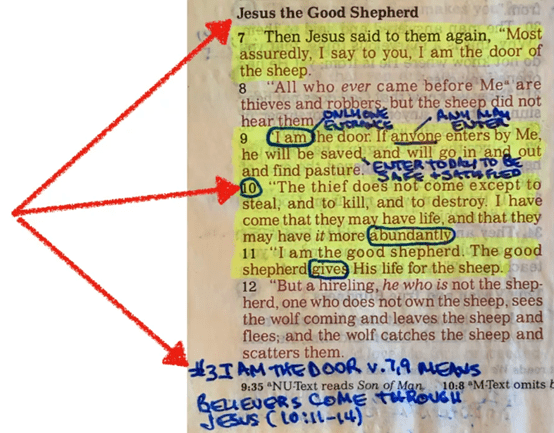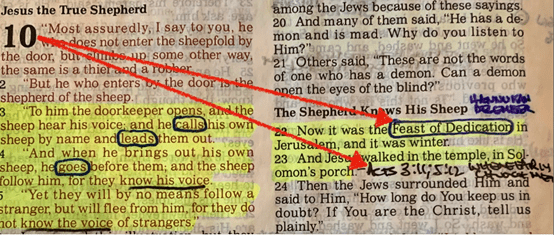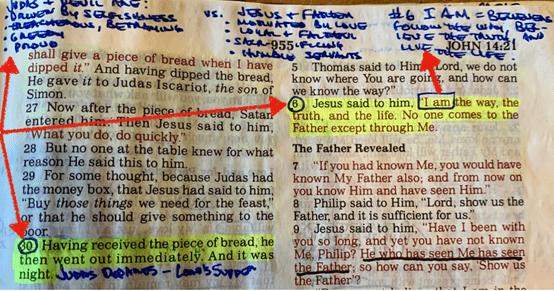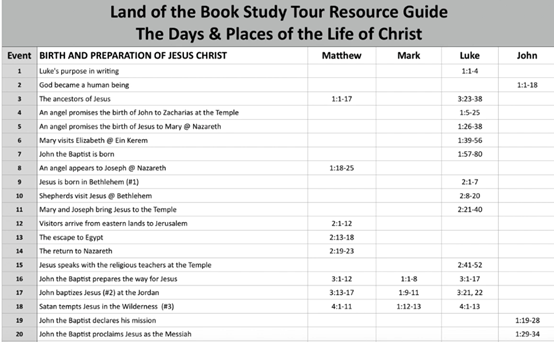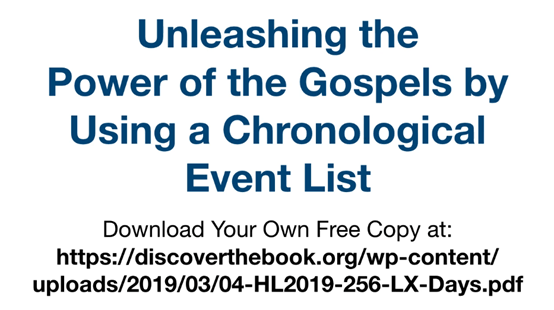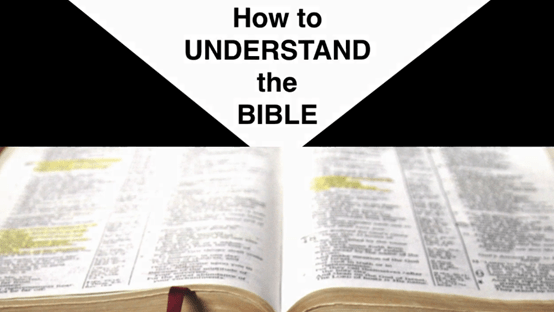Transcript
John Barnett here. Welcome to this special video recording of a question I’ve been asked, I bet, 50 times in the last couple of weeks by so many students. Basically, they said, how do you understand the Bible? They come up and they look at my Bible. They try and figure out the markings in it.
What I tell them is, the Bible is the only source for healing the mind, ending our fears, erasing hurtful abuse from the past, and also unleashing divine, joy and rejoicing.
Now, most of us know that the Bible on recorded disc, an audio Bible like on your phone or iPad or whatever, is only 72 hours long. It takes a sixth grader, to read out loud the whole Bible, just 72 hours if they just sit there and read it.
Most of us, most believers haven’t really read the Bible and really are struggling. Basically, it’s because, there’s over 31,000 verses in 1,189 chapters, spread across those 66 books and we just don’t know quite how to study it. How to get a comprehensive grasp.
My goal today is to unleash the power of the Gospels, one portion of the Bible, those first four books of the New Testament using a chronological event list. Now you say, what is that? You can download one. They’re actually for sale on many Christian book distributors, it’s called the harmony of the Gospels. This is a simple one. It’s just one I use in my classes. It’s right there at that link. You can download that anytime you want if you want to actually use it and follow along.
Now, for those of you that like to see this in action, there are videos on YouTube on our channel, we have an entire channel that’s devoted to the teaching in all these classes that you can follow along with. There’s a playlist there, do you see the yellow link, and that is all of these Gospel’s geographic, historic, chronological videos using this material.
So, here’s the chart. If you go and download it, this is what you’ll see. It’s the days and places of the life of Christ. Now, basically on the chart, down the left column are the events. There are over 250 events in the life of Christ. The four Gospels are 89 chapters, and they record 256 events that occur in the life of Christ. Then, these are categorized by major events. The birth and preparation of Jesus Christ is this opening part. Then, what you see there are the four Gospels. Now notice they’re parallel columns. Matthew all the events. If they are recorded in Matthew, in Mark and you notice the first column only has 1, 2, 3, 4, 5, 6, before Mark has anything. Luke starts earlier, and these are chronological by the way, and John’s. So, you see, there’s the four Gospels on the right, the event number, and then the description of the event.
Now, God becoming a human being, that’s the incarnation of Christ. You notice that’s only mentioned in the Gospel of John, that far right column, chapter 1 and those first 18 verses. Now look at this one, the 11th event, Mary and Joseph bringing Jesus to the temple. Did you know, that’s only recorded in Luke? Notice the other four columns are empty. See, that’s what’s so neat. You’re looking at the events of the New Testament Gospels, in order, and seeing whether or not they occur in 1, 2, 3, or 4 Gospels. Here’s another one. Satan temps Christ in the wilderness. You notice that the first three Gospels, those are called the synoptics; Matthew 4, Mark 1, and Luke 4 all record that event. It’s very exciting to use this resource.
Now again, we’re looking at another major division. The message and ministry of Jesus Christ. Notice something right in the middle of that slide. See the yellow line? This is the first event that’s in Matthew, Mark, Luke, and John. Now, there aren’t very many events that are in all four Gospels. These are like the ones that God draws a line under and says, hey, pay attention to this. This is the launch of Christ’s ministry. Matthew 4 records His first public words after His temptation, as He goes out and preaches. What’s fascinating is, what’s the very first topic that Jesus preaches on? He says repent. You can learn that by following along Matthew, Mark, Luke, John, and see the entire launch of Christ’s ministry.
Notice Matthew, Mark, and Luke. How many times you’ll see those three all are addressing those events. Like event 45, 46, right there on your chart. 45 and 46. The disciples are picking wheat as they are walking through Galilean fields and Jesus heals a man’s hand on the Sabbath day.
Those two events are recorded in the same three Gospels but notice John doesn’t record these. Now, what’s going on here? This is what we call in theology and you’ve probably have heard in Sunday School, the synoptic Gospels. Matthew, Mark, and Luke are synoptic. Syn Optic. That means they see together. They’re looking at the same events from three different angles. You really get amazing details. Everything happens somewhere.
Now, look at this one, I’m just underlining event. number 68. It’s when a Roman soldier demonstrates faith in Capernaum. Wow. That means we know where this happened. That’s where Bible study gets so exciting. I have a map. I actually am following along. I’m looking at where Jesus is when He is teaching this, or performing that miracle, or spending time with His disciples. So, what you see is, what happened in Matthew 8:5-13 also took place in Luke 7:1-10 but often only one of the Gospels tells where the event took place.
If you use this guide, this chronological, geographic guide to the events of Christ’s life and the Gospels, you will be able to mark in your Bible where the event happened if it’s not noted there, by using this column side by side historic chronology of the scriptures.
Now notice, same thing, event 71. It says this took place Matthew 11:20-30 in the sacred triangle. Now what is the sacred triangle? The sacred triangle is the amazing three cities that Jesus performed two thirds of all of His miracles in. Of Christ’s recorded 36 miracles, 24 of them are in Capernaum, Bethsaida, and Chorazin. That’s the sacred triangle and so that’s what this shows. Now notice, Capernaum right there and sacred triangle right there, those are two details. This chart has not only the book of the Bible that is in, Matthew, Mark, Luke, or John, but bolded the place.
Now, here at the bottom, event number 96. Notice what it says. It says Jesus feeds the 5,000. That’s the second event that’s in all four Gospels. So, this is huge. Number one, Jesus launches His ministry. Number two, He feeds the 5,000. Notice what it says right at the end of that event, sign number four. The Gospel of John is built around the signs. There are seven of them. Actually. It actually tells us from John’s Gospel that he said, these signs were written that you might believe Jesus Christ is the Son of God, but this chart records for you the signs.
Now, look at this page. We’re starting on event227 and that’s fast forwarded to the end. Notice how many yellow ones we have now because the death of Jesus Christ are the events that all four Gospels focus on. See, the purpose of Bible study is to bring us to Christ and the purpose that Christ came is, to give Himself as a substitutionary sacrifice.
Just a few details. Number one, Gethsemane. Do you see the bold there? The events occurred in that specific place. Everything happened somewhere. That betrayal, arrest, and being forsaken by the disciples took place in Gethsemane notice what this one is. It says after event number 238, the first three hours of the crucifixion, that’s the fifth event in the life of Christ. Now you say, whoa, too many things going on here. There are signs and there are events. The life of Christ is summarized by seven events. His birth, His baptism, His temptation, and then His death, His burial, His resurrection, and His showing Himself alive.
Those 7 events are built around a center event, which is number four. The transfiguration. So, His birth, His baptism, His temptation, His transfiguration, where God says this is my beloved son. Then His death, burial, resurrection. This happens to be number five of the seven. One last thing for you to see. There’s the 6th event, His resurrection from the dead and then His Ascension will be later.
Look at the top, event 245, and notice that all four Gospels talk about the garden tomb. Then we start seeing the appearances of Christ. He appears first to Mary Magdalene, then He appears secondly to the women at the garden tomb, and then He appears to those on the road to Emmaus. Mark records that, Luke records that. Not all of these events are in all four of the Gospels. Then Jesus’ fourth, fifth, and six appearances are in the upper room. Then going from Jerusalem to the Sea of Galilee at Tabgha, that’s on the shore of the sea of Galilee, and that’s where Jesus appears to the disciples while they’re fishing. One last thing, looked down at the Ascension to Heaven. That’s the seventh event. In the life of Christ. Now, this is the chart, download it if you haven’t, but let me show you what can happen if you use this chart.
I’m just going to give you some pages from my Bible. I just sat here because when you come up to me at the conferences or when you stopped by after a class you say, can I see your Bible? Here’s what many of you asked for. That’s my Bible. Now look at this, using that chart I found that in the Gospel of John chapter 5, this is the third of the seven signs. Each of them are noted in the chart, that Jesus performed to prove who He was. So, sign number three is in John’s Gospel, chapter 5. It’s the man that’s paralyzed and laying there by the pool of Siloam, I’m sorry, the pool of Bethesda. Now notice it says in verse 54 of chapter 4. The second sign is in John chapter 4. The third sign is in John chapter 5. Now notice what I’ve also written right there in parenthesis, I write down where the next sign is so I can daisy chain and actually go from one sign to the next. The first one’s in chapter 2. It’s the water into wine. The second one is in chapter 4. That’s Jesus healing the nobleman’s son. The third one is right here at the pools of Bethesda, in John chapter 5. The next sign, the fourth one is in chapter 6 of the Gospel by John.
Now, here’s another page out of my Bible. It’s John chapter 6. Now notice what’s at the top, right there. This is the fourth of the seven signs, feeding the 5,000, in John 6:1-14, if you can read my writing. Now look what I write after that, this feeding the 5,000, John 6:1-14 teaches that salvation brings inexhaustible satisfaction. What did Jesus feed the 5,000? Why is this recorded in all four Gospels? Because He says if you understand the Gospel, if you receive me, you have inexhaustible satisfaction. You’ll never hunger. You’ll have endless joy, delight, and satisfaction.
Now look right there, sign number five. Do you see in parenthesis, John 6:16-21? That’s the fifth sign. That’s Jesus calming the storm on the sea. Remember the disciples were in the boat. They were there all night, actually nine hours in a big storm. They were sinking. Jesus is watching them, praying. In your chronological chart you’ll notice that Matthew 14 records those details of Jesus praying all night for them. Then, He comes walking across the water to them. Peter dramatically jumps out and says, let me come to you and he does. Do you notice what it says when you read that? Look in your Bible. When Jesus got into the boat, the storm was calm. Wow.
What’s that sign about? It teaches us that salvation brings supernatural peace into our lives. Bible study isn’t just to get facts. From the facts we get lessons, and we apply those lessons by prayer. If you’re saved, sign four says Jesus offers this inexhaustible satisfaction. Say Lord, I want that. In fact, in my journal I will study a passage, I’ll summarize what it’s about, then I always end with an application prayer. Jesus satisfy me, you promised it, I want it by faith, I asked for you to do that work in my life, Jesus bring me supernatural peace.
There’s something else, look at this. Where did it take place? That’s why it’s in the chart. This event of Jesus teaching on the bread of life took place in Capernaum.
Let’s go to John chapter 8. If you’re using the chart in John chapter 8 you’ll notice that, sorry in John chapter 6. That little 8:12 is something I’m going to mention in just a second, but Jesus gives His first “I am” in John chapter 6 and verse 35. Notice what it says in verse 35. “And Jesus said to them, “I am the bread of life.” Seven times, Jesus talks about describing Himself with the Old Testament name of God in Exodus 3. The Lord revealed Himself to Moses and He said in Hebrew hāyâ ‘ăšer hāyâ. In Hebrew, that means I Am: that I Am. That’s what Jehovah means or Yahweh, it means the self existent one. Jesus takes that title and in the Gospels applies it to Himself.
By the way, the Jews of the day understood what He was saying, and they kept picking up stones. So, this is the first “I am.” By the way, they didn’t believe He was God, the majority of them, and they wanted to kill Him. Jesus was revealing Himself as the I Am. Now notice what’s in parenthesis right next to it, because this is the first “I am.” In John 6:35, “I am the bread of life. He who comes to me shall never hunger, and he who believes in me shall never thirst.” The second “I am,” right there where that arrow is pointing is in chapter 8, verse 12. So, that’s how I daisy chain, so I can find all the “I am’s,” all the signs, all of these things you’ll see in my Bible. I always put in parenthesis where the next one is.
Now, one more thing, look at this. “I am” number one – Believer’s hunger for Jesus. Jesus revealed Himself as the bread of life. If I’m a true believer, He puts inside of me what Peter talked about. Like a newborn baby I hunger for God. I thirst, as Jesus said, for His righteousness.
Look at verse 37, now this is a bonus, but it’s just because this is a page out of my Bible. One of the things people are always asking about is the tension between Calvinism and Arminianism. There is an amazing tension always in the scripture. Look at verse 37, Jesus said, this is John 6, verse 37. “All that the Father gives me…” That’s a statement of the biblical doctrine of election. God gives those to the Son as a gift to Him, that will be saved. So, “all the Father gives to me will come to me, and the one who comes to me…” there’s free will, “…I will by no means cast out.” Now, that’s amazing. Side-by-side. Election. Freewill. The Father giving and each one of us coming.
Now to explain it in a thumbnail, there’s a whole video on this. You can watch it on YouTube. Basically, it’s like two sides of the computer screen. The backside has the programming. The front side is the user interface. When you look at the front side, it just looks so simple. When you look at the backside it’s impossible for most of us to understand coding. Whether it’s Python, or C++, or visual basic, it doesn’t matter. Most people don’t understand programming. Most people don’t understand the tension between election and freewill. Before I go too far, look down at the bottom. Jesus says, “I am,” 23 times in the Gospels by John, the fourth Gospel. But seven are metaphoric names of how we, who are His own, relate to Him. “I am the bread” is first. So, we first relate to Christ by receiving Him as our only hope of life.
Going on in chapter 6, look what I wrote at the bottom of the page under verse 59. This is very important. Jesus gives this bread of life discourse. One of the most important sermons He gave in Capernaum. See how it says, in verse 59, “these things He said in the synagogue,” by the way it’s still there today, “…as He taught in Capernaum.” Very, very exciting. Synagogue. Capernaum. Bread of life discourse. That’s something that I put in my Bible to always remind me.
Now, we go to chapter 8 that I mentioned. In John 8, look at verse 12. Down at the bottom of the page. “Then Jesus spoke to them again, saying, ‘I am the light of the world.’ “ Now notice what I wrote at the top of the page. This is the second “I am.” Jesus said, “I am the light of the world.” Notice in parenthesis …third “I am” is going to be in chapter 10. What this “I am” means, light of the world in 8:12 of John means, believers walk in the light. The evidence of salvation is, I hate darkness. I’ve been turned from darkness to light and notice what it says, Jesus said in verse 12, “…he who follows me shall not walk in darkness, but have the light of light.”
Now, literally this word, not, is better translated like it is everywhere else, as never. It says in chapter 6, verse 35 you’ll never hunger. Same construction. It says in chapter 8, verse 51 that we will never be separated and never walk in darkness. Never perish. They’re all the same. There are a whole host of these in the Gospel of John. I just wanted to point that one out to you.
Now look at chapter 9. We’re going to go to the sixth sign. See, it’s written up there at the top of the page. The blind man healed. Remember, Jesus puts mud in his eyes and he walks to the pool of Siloam and wipes his eyes. That sign means, salvation opens our eyes to see. Look what Jesus says in verse 7 of chapter 9 of the Gospel by John. “And He said to him, ‘Go, wash in the pool of Siloam’ (which is translated, sent). “ God opens our eyes the moment of our salvation. We were born blind, spiritually blind. We can’t see God; we can’t understand the Bible. We don’t know what’s going on and all of a sudden, boom. The miracle of salvation opens our eyes.
In chapter 10, once we’re saved, we find out that we now have a good shepherd. See how it says that, that note in the Bible? Jesus is a good shepherd. That’s John chapter 10. Jesus starts saying something in this verse. This is what He says. “I am the door. If anyone enters by me, he will be saved, and will go in and out and find pasture. The thief does not come except to steal, and kill, and to destroy. I’ve come that they might have life, and they may have it more abundantly.” We walked through the door of salvation and that’s a person. Salvation as a person. It’s Jesus Christ. He’s the doorway. He’s the only way in. He is the entrance. So, I wrote right there at the bottom of the page, I am the door means believers come through Jesus. He’s the only way. He’s the only way to the Father. He’s the only way of salvation. He is the exclusive one and only hope of salvation. Salvation is a person. He’s the good shepherd.
In chapter 10 and verse 14, notice what Jesus says, “I am the good shepherd; and I know my sheep, and am known by my own.” Right there at the top. You find each of these in that chart that you can download the 256 events chronologically. The fourth “I am” is right here in John 10. It’s in verse 11, notice at the top and verse 14. What it means is, believers follow Jesus. We follow our good shepherd. He knows us, but we hear His voice.
The first time I heard the voice of Jesus Christ was His conviction. As my parents read the scriptures to me, in my heart I could hear the Lord saying to me, you are a sinner. You are lost. You need salvation. That’s hearing His voice. I heard His voice this morning. Every time I study the Bible, I hear the voice of God because, Jesus is my good shepherd.
John chapter 10, look at this, see that red arrow? Verse 22, “it was at the Feast of Dedication…” Now, most people are comfortable, well adjusted readers. You read that in John 10:22, and you think, huh? Wonder what that is. You keep reading because in America, our goal is progress. We just want to read, read, read, read. But the Feast of Dedication, if you look in a study Bible, is Hanukkah. Takes place in December. So, Jesus, we know He’s walking into temple in December, at the time of Hanukkah, the feast of all those lights. The menorah is burning, but look at this, this is what’s so fascinating. This spot where He’s walking is Solomon’s porch. It identifies where in the temple He’s walking. The same place is mentioned in Acts 3 and Acts 5. This is where the early church met and gathered. Can you imagine standing in the spot where Jesus taught the good shepherd sermon, where He said my sheep hear my voice. I come to give you abundant life. Remember, everything happens somewhere. The Bible shows us where these magnificent, marvelous, incredible events take place.
Let’s go to John chapter 14. Right there in verse 30 of chapter 13, it says that “Having received the piece of bread, he then went out immediately. And it was night.” So that’s Judas and the Lord’s supper. Then followed by chapter 14 in verse 6 is the next “I am,” the 6th “I am.” Jesus said, “I am the way, the truth, and the life. No one comes to the Father except through me.” John 14:6. So, that “I am” is the sixth “I am.” Believer’s follow the way, believe the truth, and live the life. Wow, do you see these “I am” statements are describing what salvation is all about. Judas and the devil are the exact opposite. Jesus is motivated by love and Judas is driven by selfishness, because of Satan’s horrible work in him. You can just see this contrast, that Jesus says “I am the way” right after Satan enters Judas and the horrors of deception take place.
One last truth to look at. That is, that all of us, the instant of salvation, believe and follow the way, and believe and follow the truth, and believe and follow the one who is our life. Chapter 15 of John’s Gospel has the great “I am the true vine.” That is the seventh and final “I am” that’s in the Gospel of John. Believers abide in Jesus. By the way, look at this. 11 times in this 15th chapter, it talks about abiding. Jesus said that we are to abide in Him. Look what it says in verse 5, “for without me you can do nothing.” Now, we do a lot of things, but only when we’re abiding in Christ do they amount to anything.
Those are some lessons from this chart. Hope you’ll download it. It’s the days and places of the life of Christ. I hope you’ll find that playlist and actually see all of these places. Remember, everything happened somewhere.
I’ve actually gone out in these videos and show you every spot of the events in the life of Christ.
This is how we unleash the Gospels and their powerful message by using a chronological event list. I hope this is a blessing to you.
Let’s pray.
Father, I thank you that we can hear your voice. My sheep hear my voice, you said. Lord Jesus, I’m one of your sheep and I heard your voice. I heard it this morning, early in the dark, as I sat and went over your word, word by word, just eating and feeding my soul. I heard your voice as I walked through this day and verses came to mind. Especially when temptations or opportunities for me to not act Christ-like presented themselves, instantly your spirit prompted in my heart a verse I’d already learned. It spoke to me, that you want me to follow you. And I do by faith. Lord, I pray that everybody watching this video will hear your voice. If they’ve never come to Christ, that right now they’d say Lord Jesus, you are the way, you are the truth, you are the life. I am born into this world a child of the evil one. You said we’re of our father the devil, before we’re saved. I pray they would repent. Turn in faith to you. Ask you to open their eyes and give them that inexhaustible satisfaction in that peace that only you can give. We pray all this in the mighty name of Jesus Christ and for His glory, Amen.
Slides
Check Out All The Sermons In The Series
You can find all the sermons and short clips from this series, 52 Greatest Chapters In The Bible here
Looking To Study The Bible Like Dr. Barnett?
Dr. Barnett has curated an Amazon page with a large collection of resources he uses in his study of God’s Word. You can check it out here.


